Shining Path
One of many things that we'll be looking at tonight in the Blackout seminar that I've been teaching over at Pratt in Brooklyn is organically generated electricity—things like virus batteries, biogeobatteries, sediment batteries, and more.
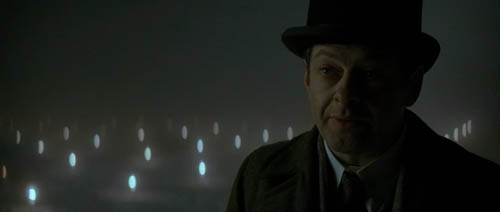 [Image: From Christopher Nolan's film The Prestige (2006)].
[Image: From Christopher Nolan's film The Prestige (2006)].
By way of getting there, though, we'll be taking a very brief look at Christopher Nolan's under-rated film The Prestige—specifically the scene in which we see a hillside covered in giant incandescent light bulbs, none of which appear to be plugged into anything but soil and all of which are powered wirelessly by a generator located over 12 miles away.
The geological form of the mountain plateau becomes a shining grid framing our two featured characters.
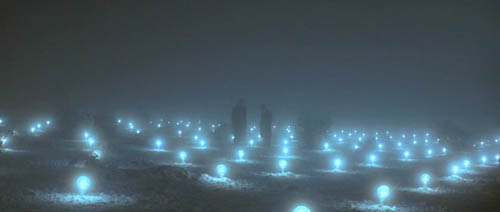 [Image: From Christopher Nolan's film The Prestige (2006)].
[Image: From Christopher Nolan's film The Prestige (2006)].
Although The Prestige does not suggest that this is what's happening in this scene, what if the soil itself was powering these light bulbs? What if soil could be turned into a landscape-scale, distributed electrical device?
Awesomely, as Nature reported just two months ago, there is growing evidence to back up "a suggestion within the geophysics and microbiology communities that bacteria can grow tiny 'wires' and hook up to form a biogeobattery—a giant natural battery that generates electrical currents."
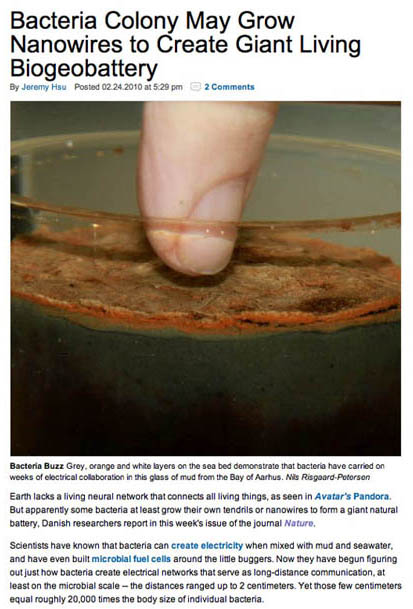 [Image: From Popular Science].
[Image: From Popular Science].
Then Popular Science picked up on the story:

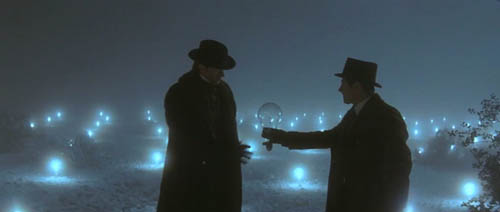
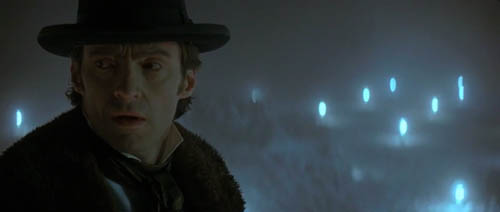 [Images: From The Prestige (2006)].
[Images: From The Prestige (2006)].
And biogeobatteries are not even the only option here; there are also virus batteries.
MIT reported back in 2006 that a team of researchers had "harnessed the construction talents of tiny viruses to build ultra-small 'nanowire' structures for use in very thin lithium-ion batteries. By manipulating a few genes inside these viruses, the team was able to coax the organisms to grow and self-assemble into a functional electronic device." The resulting virus batteries are tiny, but they could vary in scale "from the size of a grain of rice up to the size of existing hearing aid batteries."
The future design possibilities are bewildering. Could deposits of virus-impregnated soil be used as electricity-storage devices in rural, off-the-grid areas?
 [Image: From Nature].
[Image: From Nature].
After all, bacteria might already be "wiring up the soil," Nature suggested three years ago. Indeed, "bacteria can sprout webs of electrical wiring that transform the soil into a geological battery," meaning that "the earth beneath our feet might act as a gigantic circuit built by microbes to power their metabolic systems." And you can build a soil battery yourself:
You infect the soil with a genetically-modified virus patented by MIT and electrical currents start to flow...
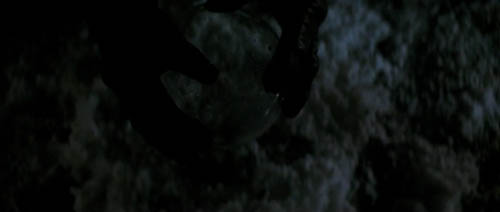 [Image: From Christopher Nolan's The Prestige (2006)].
[Image: From Christopher Nolan's The Prestige (2006)].
Perhaps someday, then, we could simply show up somewhere, in the middle of the night, surrounded by pine forests and hills, and just crouch down, push a light bulb two or three inches into the earth—
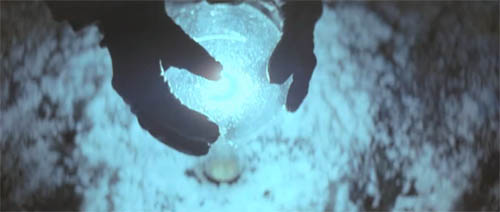 [Image: From The Prestige (2006)].
[Image: From The Prestige (2006)].
—and watch as everything around us starts to glow.
 [Image: From Christopher Nolan's film The Prestige (2006)].
[Image: From Christopher Nolan's film The Prestige (2006)]. By way of getting there, though, we'll be taking a very brief look at Christopher Nolan's under-rated film The Prestige—specifically the scene in which we see a hillside covered in giant incandescent light bulbs, none of which appear to be plugged into anything but soil and all of which are powered wirelessly by a generator located over 12 miles away.
The geological form of the mountain plateau becomes a shining grid framing our two featured characters.
 [Image: From Christopher Nolan's film The Prestige (2006)].
[Image: From Christopher Nolan's film The Prestige (2006)]. Although The Prestige does not suggest that this is what's happening in this scene, what if the soil itself was powering these light bulbs? What if soil could be turned into a landscape-scale, distributed electrical device?
Awesomely, as Nature reported just two months ago, there is growing evidence to back up "a suggestion within the geophysics and microbiology communities that bacteria can grow tiny 'wires' and hook up to form a biogeobattery—a giant natural battery that generates electrical currents."
 [Image: From Popular Science].
[Image: From Popular Science].Then Popular Science picked up on the story:
- Scientists have known that bacteria can create electricity when mixed with mud and seawater, and have even built microbial fuel cells around the little buggers. Now they have begun figuring out just how bacteria create electrical networks that serve as long-distance communication, at least on the microbial scale—the distances ranged up to 2 centimeters. Yet those few centimeters equal roughly 20,000 times the body size of individual bacteria.


 [Images: From The Prestige (2006)].
[Images: From The Prestige (2006)]. And biogeobatteries are not even the only option here; there are also virus batteries.
MIT reported back in 2006 that a team of researchers had "harnessed the construction talents of tiny viruses to build ultra-small 'nanowire' structures for use in very thin lithium-ion batteries. By manipulating a few genes inside these viruses, the team was able to coax the organisms to grow and self-assemble into a functional electronic device." The resulting virus batteries are tiny, but they could vary in scale "from the size of a grain of rice up to the size of existing hearing aid batteries."
The future design possibilities are bewildering. Could deposits of virus-impregnated soil be used as electricity-storage devices in rural, off-the-grid areas?
 [Image: From Nature].
[Image: From Nature].After all, bacteria might already be "wiring up the soil," Nature suggested three years ago. Indeed, "bacteria can sprout webs of electrical wiring that transform the soil into a geological battery," meaning that "the earth beneath our feet might act as a gigantic circuit built by microbes to power their metabolic systems." And you can build a soil battery yourself:
- The researchers filled plastic columns with wet sand infiltrated with a nutrient compound (lactate), and allowed S. oneidensis to grow in this "fake soil." Only the top of the column was in contact with air. Electrodes inserted at various heights up the columns revealed that, after about ten days, electrical charge was coursing up the column... threaded by a web of filaments between the bacterial cells.
You infect the soil with a genetically-modified virus patented by MIT and electrical currents start to flow...
 [Image: From Christopher Nolan's The Prestige (2006)].
[Image: From Christopher Nolan's The Prestige (2006)]. Perhaps someday, then, we could simply show up somewhere, in the middle of the night, surrounded by pine forests and hills, and just crouch down, push a light bulb two or three inches into the earth—
 [Image: From The Prestige (2006)].
[Image: From The Prestige (2006)]. —and watch as everything around us starts to glow.





Comments are moderated.
If it's not spam, it will appear here shortly!
Krsto Papic's Tesla has a similar scene (similarly irrelevant to the soil-energy idea) ... but just thought I'd reference this as a great film and a wonderfully laconic scene (I have a sneaking suspicion there are some references to it, though I haven't seen The Prestige). Orson Welles as J.P.Morgan. Edison tops Topsy.
Wondrous. It reminds me somewhat of The Living's River Glow project - http://www.thelivingnewyork.com/rg.htm - which is waterborne rather than earthbound, and uses thin film photovoltaics, but has a similar motive.
This was Nikola Tesla'a work. He kept lightbulbs on his desk that were provided electricity by, seemingly, the desk itself, or at least some kind of wireless source. This lit field was one of his better known research examples.
Somewhere in a book I read once, Tesla was bet that he was using some kind of long-planned trickery to light his lights and could not reproduce his experiments at will, in other locations. As the story goes, he asked his bettor to pick any point on the planet (lat/long). Tesla apparently lit a lightbulb at the coordinates at a predetermined time. If I remember correctly, that place was in Australia, while Tesla was still planted firmly in US soil.
Was Tesla the one who determined harmonic frequency/sympathetic vibration of architectural structures? There was a Mythbusters about it too.
i was going to chime in about tesla, but matthew already noted it.
perhaps when chile runs out of copper this will be the new technology for power transmission. i like, super cheap and dispersible, with ethereal qualities as you noted.
And related: algae with gold electrodes implanted:
http://www.engadget.com/2010/04/15/stanford-researchers-harvest-electricity-from-algae-unkempt-poo/
A wonderful post, with a strong resonance to Beethoven: "Music is the electric soil in which the spirit thinks, lives and invents. All that’s electrical stimulates the mind to flowing surging musical creation. I am electrical by nature."
Matthew and faslanyc, you guys should definitely watch The Prestige at some point—the scene in question is actually Tesla's assistant showing Hugh Jackman's character how Tesla electrified the then-frontier town of Colorado Springs. Tesla himself is a major character in the film, and he's played by David Bowie... which is not as bad as it might at first sound. It's by no means a perfect film, but it seems to have been overlooked since it first came out in 2006. I think it's worth a view, though.
The Blackout seminar conversation was interesting that night, on another note, encompassing everything from Philip Beesley to Avatar, by way of bacterial paintings inside petri dishes and what might happen if bioluminescent genes were spliced into a rapidly growing, invasive weed like kudzu—and that weed were to escape into the wild.
The Prestige is indeed worth a view. I watched it three times and, among other things, Nikola Tesla caught my attention and that scene in Colorado Springs.
In connection with biogeobatteries, I think it is also worthy to note a speech by Dan Brown in some conference where he said that, through his research for the Da Vinci and Angels and Demons books, he found out that a group of physicists today believes that everything around us is just an "energy" manifesting itself in various forms for us to comprehend and "see".
Tapping into any organism, or physical object for that matter, to generate energy is highly possible...
This brings us to a question: If matter is simply "trapped energy... then is it merely a coincidence that the vast majority of ancient texts describe god as energy, and god is all around us?"
And then I found this: a lamp which works on mud (and bacteria). Now you can make your own Tesla garden at home!
http://mariekestaps.nl/projects_soillamp.html
Thanks for the link, alicebob! Very interesting.
A fascinating idea to be able to power a bulb by the very Earth itself under ones feet. I could easily imagine such bulbs being sent out to remote villages around the World where there is scant electricty...and a young boy or girl can "plug" in a bulb into the ground and be able to sit next to it reading and learning.
I sincerely hope such technology will grow into fruition in the coming decade!
Post a Comment